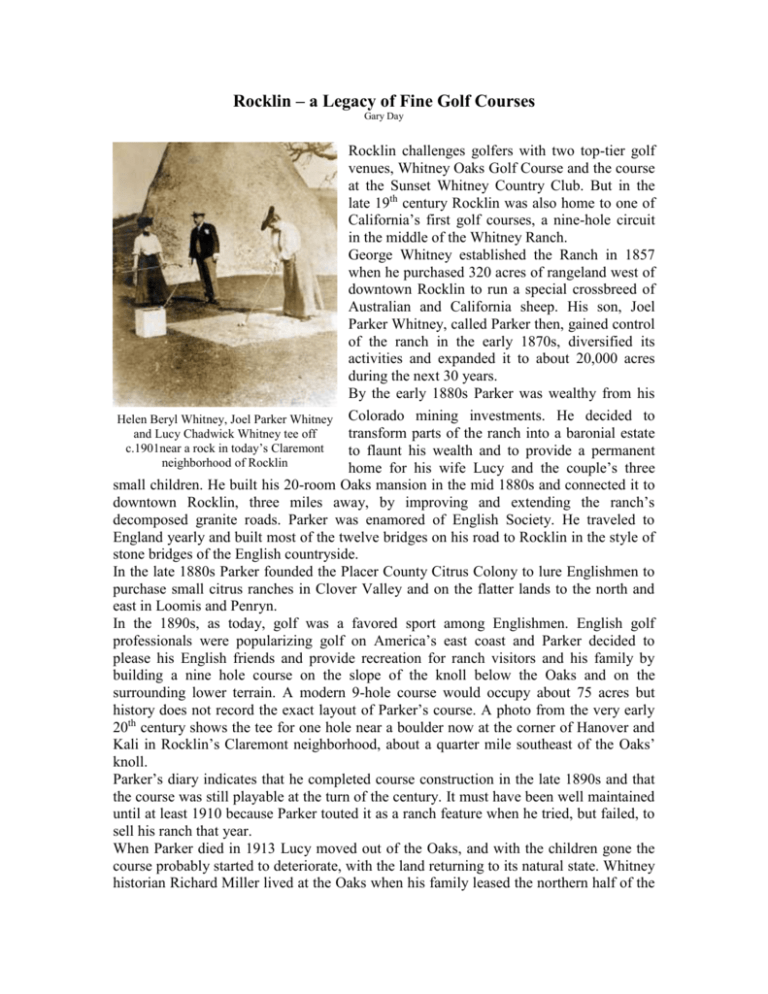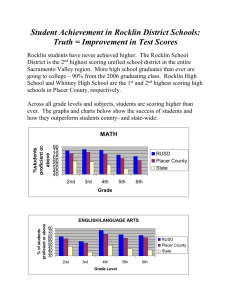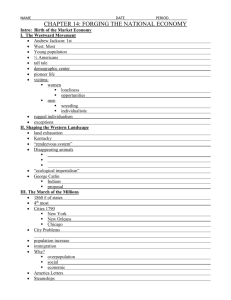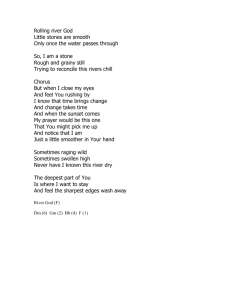Whitney Tomb - the Rocklin Historical Society
advertisement

Rocklin – a Legacy of Fine Golf Courses Gary Day Rocklin challenges golfers with two top-tier golf venues, Whitney Oaks Golf Course and the course at the Sunset Whitney Country Club. But in the late 19th century Rocklin was also home to one of California’s first golf courses, a nine-hole circuit in the middle of the Whitney Ranch. George Whitney established the Ranch in 1857 when he purchased 320 acres of rangeland west of downtown Rocklin to run a special crossbreed of Australian and California sheep. His son, Joel Parker Whitney, called Parker then, gained control of the ranch in the early 1870s, diversified its activities and expanded it to about 20,000 acres during the next 30 years. By the early 1880s Parker was wealthy from his Helen Beryl Whitney, Joel Parker Whitney Colorado mining investments. He decided to and Lucy Chadwick Whitney tee off transform parts of the ranch into a baronial estate c.1901near a rock in today’s Claremont to flaunt his wealth and to provide a permanent neighborhood of Rocklin home for his wife Lucy and the couple’s three small children. He built his 20-room Oaks mansion in the mid 1880s and connected it to downtown Rocklin, three miles away, by improving and extending the ranch’s decomposed granite roads. Parker was enamored of English Society. He traveled to England yearly and built most of the twelve bridges on his road to Rocklin in the style of stone bridges of the English countryside. In the late 1880s Parker founded the Placer County Citrus Colony to lure Englishmen to purchase small citrus ranches in Clover Valley and on the flatter lands to the north and east in Loomis and Penryn. In the 1890s, as today, golf was a favored sport among Englishmen. English golf professionals were popularizing golf on America’s east coast and Parker decided to please his English friends and provide recreation for ranch visitors and his family by building a nine hole course on the slope of the knoll below the Oaks and on the surrounding lower terrain. A modern 9-hole course would occupy about 75 acres but history does not record the exact layout of Parker’s course. A photo from the very early 20th century shows the tee for one hole near a boulder now at the corner of Hanover and Kali in Rocklin’s Claremont neighborhood, about a quarter mile southeast of the Oaks’ knoll. Parker’s diary indicates that he completed course construction in the late 1890s and that the course was still playable at the turn of the century. It must have been well maintained until at least 1910 because Parker touted it as a ranch feature when he tried, but failed, to sell his ranch that year. When Parker died in 1913 Lucy moved out of the Oaks, and with the children gone the course probably started to deteriorate, with the land returning to its natural state. Whitney historian Richard Miller lived at the Oaks when his family leased the northern half of the ranch and ran cattle there in the late 1930s. Miller remembers that only vestiges of the course were visible then. Parker’s golf course is now covered by residential neighborhoods near Mansion Oaks Park. Sunset International Petroleum Corporation built Rocklin’s second golf course, Sunset Oaks, in the early 1960s. It opened for play in June 1963. It is at the foot of Clover Valley surrounding Sunset Hill and it extends southward toward Roseville. Sunset Oaks was the centerpiece of a self-contained metropolis that Sunset intended to develop on the southern 12,000 acres of the Whitney Ranch. Sunset built their course to PGA competition standards in order to host an annual PGA tournament, the Sunset Camellia Open. According to former Sunset Vice President Dale Stringfellow, Sunset was flush with cash from the sale of a Southern California oil refinery at that time and spent willingly to ensure that the pros had the best of championship conditions, including specially constructed greens. Sunset also provided access under Midas Avenue to a planned 9-hole executive course on the north border of Sunset Oaks in lower Clover Valley. California touring golf pro Bob McAllister won the first Sunset Camellia Open in October 1964. But big name pros like Arnold Palmer and Jack Nicklaus didn’t appear and, despite intensive coverage by local media, galleries were thin. This tournament was Rocklin’s first and only experience with top PGA touring pros and its failure to draw big crowds was a marker for slow home sales and the demise of the Sunset City project in the mid 1960s, National Golf Courses Corporation bought Sunset Oaks in 1966 and changed the name to Sunset Whitney Ranch. A later owner changed the name to Sunset Whitney Country Club. The site of Sunset’s planned executive course is now covered by a residential neighborhood along Rawhide Avenue. According to Rocklin City staff, Rocklin’s third golf course, Whitney Oaks, started life in the early 1990s as a Landmark Land Development Company course called Stanford Oaks. Landmark encountered financial problems and abandoned the project before starting construction. Live Oak Enterprises built Whitney Oaks Golf Course in the mid 1990s on the land intended for Stanford Oaks. The course opened for play in 1997. Whitney Oaks covers the middle of a 250+ acre canyon-like valley which was the vineyard and orchard in the late 19th century of Parker’s friend O.T. Brown. Parker provided water to Brown’s valley in the late 19th century. He purchased it in 1901 and integrated it into the Whitney Ranch.






